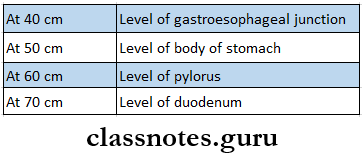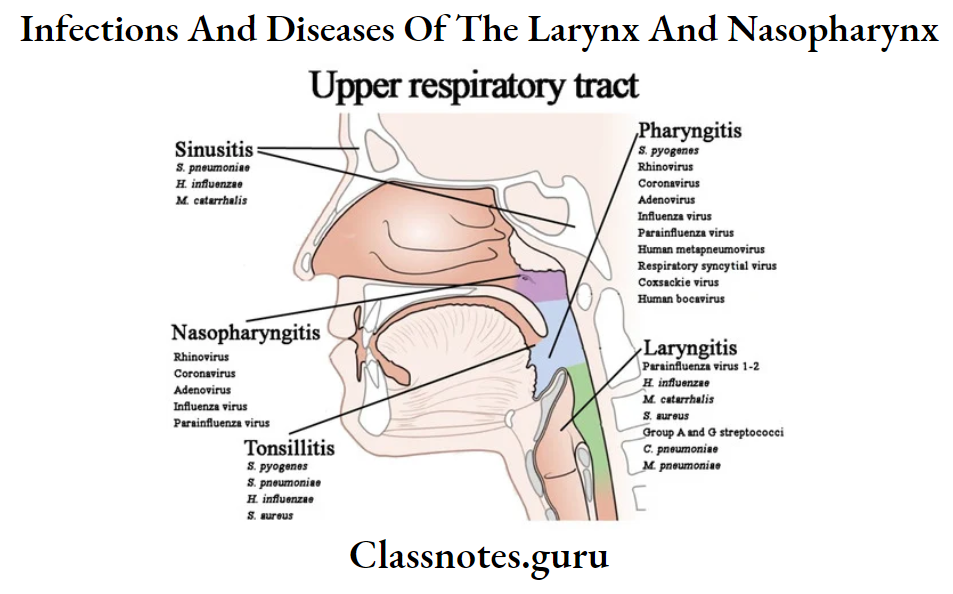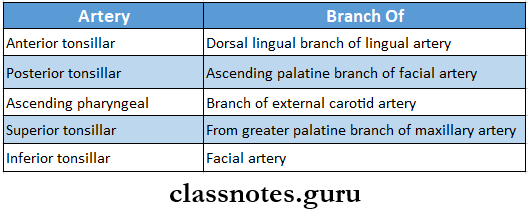Infections And Diseases Of The Larynx And Nasopharynx Important Notes
- Arteries Supplying Tonsils
- Anterior tonsillar
- Posterior tonsillar
- Ascending pharyngeal
- Superior tonsillar
- Inferior tonsillar
- Acute Tonsillitis
- It is generalised inflammation of the tonsils
- Causative Organisms
- Viral
- Bacterial
- Acute Tonsillitis Types
- Acute catarrhal tonsillitis
- Acute follicular tonsillitis
- Acute parenchymatous tonsillitis
- Acute membranous tonsillitis
- Acute Tonsillitis Clinical features
- Sore throat
- Difficulty or painful swallowing
- Earache
- Enlai’ged and congested tonsils
- Cervical lymphadenopathy
- Quinsy
- Collection of pus in peritonsillar space is called quinsy
- Causative Organisms
- Streptococcus pyogenes
- Staphylococcus aureus
- Anaerobes
- Quinsy Clinical Features
- Severe pain in throat
- High temperature
- Dysphagia
- Dribbling of saliva
- Trismus
- Torticollis
- Bulging of tonsillar, peritonsillar, and palatal region
- Cervical lymph nodes are tender and enlarged
- Ryle’s Tube
- Ryle’s Tube is one meter long tube made up of red rubber or plastic
- Ryle’s Tube has got markings at different levels

- Obstructive Lesions Of Oesophagus
- Oesophageal stricture
- Oesophageal cancer
- Lower oesophageal ring
- Dysphagia
- Scleroderma
- Achalasia
Laryngeal infections and diseases Q&A
Infections And Diseases Of The Larynx And Nasopharynx Long Essays
Question 1. Describe signs, symptoms, and treatment of carcinoma of larynx
Answer:
Carcinoma Of Larynx: Carcinoma Of Larynx is a malignancy involving true vocal cords and anterior and posterior commissures
Carcinoma Of Larynx Clinical Features:
- Carcinoma Of Larynx Types
- Supraglottic
- Throat pain
- Dysphagia
- Referred ear pain
- Lump in the neck
- Hoarseness of voice
- Weight loss
- Respiratory obstruction
- Persistent cough
- Haemoptysis
- Halitosis
- Supraglottic
Read And Learn More: General Surgery Question and Answers
- Glottic
- Hoarseness of voice
- Stridor
- Subglottic
- Stridor
- Hoarseness of voice
- Glottic
Carcinoma Of Larynx Investigations:
- Chest X-ray- to rule out lung disease
- Lateral veiw of the neck- to detect extension of tumor
- CT scan- to detect
- Extension of tumour
- Cartilage invasion
- Nodal metastasis
- Direct laryngoscopy
- For staging of tumour
- Microlaryngoscopy
- Biopsy- to confirm diagnosis
Carcinoma Of Larynx Treatment:
- Radiotherapy
- Indicated in early lesions when the vocal cords are not involved
- Surgery
- Done to
- Preserve voice
- Prevent permanent tracheostoma
- Allow adequate resection of tumour
- Total laryngectomy
- Structures removed are
- Entire larynx
- Hyoid bone
- Pre-glottic space
- Strap muscles
- Tracheal rings
- Structures removed are
- Done to
- Combined Therapy
Nasopharyngeal diseases questions and answers
Question 2. Discuss the differential diagnosis of obstructive lesions in the oesophagus
Answer:
Various differential diagnoses of obstructive lesions in the oesophagus are as follows:
- Oesophageal Structure
- It is a complication of acid reflux
- Oesophagus Causes
- GERD
- Zollinger- Ellison syndrome
- Trauma from nasogastric tube placement
- Chronic acid exposure
- Oesophagus Features
- Progressive dysphagia
- Oesophageal Cancer
- Oesophageal Cancer Clinical features
- Progressive dysphagia
- Insidious in onset
- Retrosternal discomfort
- Indigestion
- Weight loss
- Mild anaemia
- Hoarseness of voice
- Oesophageal Cancer Treatment
- Radiotherapy
- Surgery
- Resection
- Intubation
- Laser photocoagulation
- Diathermy
- Oesophageal Cancer Clinical features
- Lower oesophageal Ring
- Schatzki’s ring
- Lower oesophageal Ring is an oesophageal web in its lowermost part
- Lower oesophageal Ring contains only mucosa and submucosa
- Covered by squamous epithelium- above and columnar epithelium- below
- Appears at the Squamocolumnar junction
- Lower oesophageal Ring is asymptomatic
- Dysphagia lusoria
- Dysphagia lusoria is caused by compression of the esophagus from any congenital vascular abnormality
- The abnormality may be in
- Aberrant right subclavian artery
- Double aortic arch
- Right aortic arch with left ligament- martyrium
- Scleroderma
- Scleroderma is a collagen vascular disease of unknown etiology
- Scleroderma Features
- Induration of skin
- Fibrous replacement of the smooth muscle of internal organs
- Dysphagia
- Severe heartburn
- Scleroderma Treatment
- Treat gastro-oesophageal reflux disorder
- Use of H2 inhibitors like cimetidine or ranitidine
- Achalasia
- In it peristalsis is absent
- Lower oesophageal sphincter fails to relax during swallowing
- Achalasia Features
- Dysphagia
- Regurgitation
- Weight loss
- Achalasia Treatment
- Use of calcium channel antagonist
- Mechanical dilatation
- Oesophago cardiomyotomy
Question 3. Mention the indications for tracheostomy. Describe the steps of the operation
Answer:
Tracheostomy: Tracheostomy is a procedure of making an opening in anterior wall of trachea and converting it into a stoma on skin surface
Tracheostomy Indications:
- To bypass obstructions
- Infections
- Trauma to larynx
- Tumour
- Foreign body
- Laryngeal edema
- Congenital anomaly
- Supraglottic or glottic pathologic condition
- Retained secretions
- Comatose patient
- Respiratory muscle paralysis
- Painful cough
- Aspiration of pharyngeal secretions
- Respiratory insufficiency
- Emphysema
- Chronic bronchitis
- Facial fractures
- To provide a long-term route for mechanical ventilation
- Prophylactic
- Severe sleep apnoea
Tracheostomy Steps:
- Position the unconscious patient in a supine position with the neck extended
- Vertical skin incision is given n Veins are ligated n Muscles are separated
- Subcutaneous fat is removed with electrocautery to aid in exposure
- Thyroid gland is retracted upwards n Trachea is exposed
- 4% xylocaine is infiltrated into the trachea
- Suction secretions and blood out of the lumen
- n Place appropriate size tracheostomy tube with an inflated cuff
- Secure it to the skin with 4-0 permanent sutures
- Attach a tracheostomy collar
- Place a sponge soaked in iodine between the skin and the flange for 24 hours
Short questions on larynx and nasopharynx infections
Question 4. Discuss the types, postoperative management, and complication of tracheostomy.
Answer:
Tracheostomy Types:
- Emergency
- Elective
- Permanent
Tracheostomy Postoperative Management:
- The site should be kept clean and dry to minimize infection
- Monitor
- Bleeding
- Breathing difficulty
- Displacement of tube
- Subcutaneous emphysema
- Irrigate with normal saline regularly
- Suctioning done regularly in every Vi hour
- Use of humified oxygen
- Use of mucolytic agents
- Deflate cuff every hour for 5 minutes
Tracheostomy Complications:
- Immediate complications
- Bleeding
- Apnoea
- Pneumothorax
- Injury to adjacent structures- recurrent laryngeal nerve, vessels, and oesophagus
- Postobstructive pulmonary edema
- Endotracheal tube ignition
- Early complication
- Bleeding- due to increased blood pressure
- Plugging of mucus
- Tracheitis
- Cellulitis
- Displacement of tube
- Subcutaneous emphysema
- Intermediate complications
- Secondary infection
- Blockage of tube
- Late complications
- Tracheal stenosis
- Scar
- Tracheomalacia
- Tracheoesophageal fistula
- Tracheocutaneous fistula
- Granulation

Infections And Diseases Of The Larynx And Nasopharynx Short Essays
Question 1. Retropharyngeal abscess
(or)
Chronic retropharyngeal abscess
Answer:
Retropharyngeal Abscess: The collection of pus in retropharyngeal space is called a retropharyngeal abscess
Retropharyngeal Abscess Types:

Question 2. Peritonsillar abscess
(or)
Quinsy
Answer:
Peritonsillar Abscess
The collection of pus in peritonsillar space is called quinsy
Peritonsillar Abscess Etiology:
- Acute tonsilitis
- De novo
- Causative organisms
- Streptococcus pyrogens
- Staphylococcus aureus
- Anaerobic organisms
Peritonsillar Abscess Clinical Features:
- High-grade fever with chills
- Malaise
- Headache
- Neck pain
- Throat pain
- Dysphagia
- Change in voice
- Oralgia
- Odynophagia
- Nausea
- Constipation
- Trismus
- Halitosis
- Ipsilateral earache
Peritonsillar Abscess Treatment:
- Conservative
- 4 fluids
- Systemic antibiotics
- Analgesics
- Antipyretics
- Surgical treatment
- Needle aspiration- to drain the abscess
- Incision and drainage for larger abscess
- Tonsillectomy
Peritonsillar Abscess Complications:
- Parapharyngeal abscess
- Laryngeal oedema
- Septicaemia
- Endocarditis
- Lung abscess
- Nephritis
- Brain abscess
- Jugular vein thrombosis
Infections of upper respiratory tract Q&A
Question 3. Acute tonsilitis
Answer:
Acute Tonsilitis
Acute Tonsilitis is inflammation of the tonsil
Acute Tonsilitis Types:
- Acute catarrhal tonsillitis
- Seen in viral infections
- Acute follicular tonsilitis
- Crypts are filled with purulent material
- Acute parenchymal tonsilitis
- Tonsils are inflamed and enlarged
- Acute membranous tonsilitis
- Exudates from crypts form a membrane over the surface
Acute Tonsilitis Etiology:
- Hemolytic streptococci
- Staphylococci
- Pneumococci
Acute Tonsilitis Clinical Features:
- Sore throat
- Dysphagia
- Fever
- Earache
- Headache
- Abdominal pain
- Body ache
- Malaise
- Fetid breath
- Coated tongue
Acute tonsilitis Treatment
- Bed rest
- Increased fluid intake
- Analgesics
- Antibiotics
Infections And Diseases Of The Larynx And Nasopharynx Short Answers
Question 1. Quinsy
(or)
Peritonsillar abscess
Answer:
Quinsy
The collection of pus in peritonsillar space is called quinsy
Peritonsillar Abscess Etiology:
- Acute tonsilitis
- De novo
- Causative organisms
- Streptococcus pyrogens
- Staphylococcus aureus
- Anaerobic organisms
Peritonsillar Abscess Clinical Features:
- High-grade fever with chills
- Malaise
- Headache
- Neck pain
- Throat pain
- Dysphagia
- Change in voice
- Oralgia
- Odynophagia
- Nausea
- Constipation
- Trismus
- Halitosis
- Ipsilateral earache
MCQs on laryngeal diseases
Question 2. Tracheitis
Answer:
Tracheitis
Tracheitis is the inflammation of the trachea
Tracheitis Causative Organism:
- Staphylococcus aureus
- Clinical Features:
- Fever
- Stridor
- Tachypnoea
- Respiratory distress
- High WBC count
- Cough
Tracheitis Treatment:
Systemic antibiotics
Question 3. Pharyngitis
Answer:
Pharyngitis
Pharyngitis is an infection of the pharynx
Pharyngitis Etiology:
- Infections
- Allergy
- Trauma
- Toxins
- Neoplasia
Pharyngitis Clinical Features:
- Pharyngitis can be acute or chronic
- Enlarged tonsils
- Difficulty in swallowing and breathing
- Cough
- Fever
Question 4. Arterial supply to tonsils
Answer:
Arterial Supply To Tonsils

Viva questions on nasopharyngeal conditions
Question 5. Collar stud abscess
Answer:
Arterial Supply To Tonsils
- Arterial Supply To Tonsils is an acute suppurative infection of a digit presenting as a stud-like blister
- Arterial Supply To Tonsils results when a cold abscess which is deep to deep fascia ruptures through the deep fascia and forms another swelling in the subcutaneous plane which is fluctuant
Collar Stud abscess Treatment:
- Simple incision does not resolve the case
- Nondependent aspiration avoids the formation of sinus
- Systemic antibiotics are preferred
Question 6. Pharyngocele
Answer:
Pharyngocele
- Pharyngocele refers to the lateral pharyngeal wall herniation
Pharyngocele Clinical features
- Dysphagia
- Lateral cervical mass
- Valsalva maneuver
- It is diagnosed by pharyngoesophageal swallow
Question 7. Endotracheal intubation
Answer:
Endotracheal Intubation
- Endotracheal intubation secures the airway by placing a tube into the trachea either via nose, mouth, or tracheostomy
- This tube has an inflatable cuff
- Once the tube is placed into the trachea, the cuff is inflated
- This prevents the aspiration of debris
- This tube is connected to an anesthetic machine to allow the delivery of oxygen, nitrous oxide, and inhalation anesthesia
- A throat pack is used as a supplement to the cuff to prevent aspiration of blood, saliva, and debris
Question 8. Nasogastric intubation
Answer:
Nasogastric Intubation
- Nasogastric intubation refers to the insertion of a nasogastric tube through the nose into the stomach
Nasogastric intubation Uses:
- In acute gastric dilatation
- To aspirate gastric contents in intestinal obstruction
- To diagnose GI bleeding
- To provide enteral feeding in comatose patients
Question 9. Acute glottic edema
Answer:
Acute Glottic Edema
- Acute glottic emdema a rare condition when not associated with an infectious disease or other clinical symptoms
- Acute Glottic Edema is one of the complication of prolonged orotracheal intubation
Acute Glottic Edema Clinical Features:
- Hoarseness of voice
- Cough
- Short expiration
- Swelling in the throat
Acute Glottic Edema Treatment:
- Application of ice externally
- Holding small pieces of ice in the back part of mouth and frequently swallowing a small piece
- Alternate hot and cold application
Question 10. Ryle’s tube
Answer:
Ryle’s Tube
- Ryle’s Tube is also called nasogastric tube
- At the end of this tube there are lead shots
- After introducing within the stomach its position is confirmed by pushing 5-10 ml of air and auscultating in the epigastrium
- Ryle’s Tube is a long tube having 3 marks
- When the tube is passed upto 1st mark it enters stomach
- Usually it is passed upto 2nd mark
Ryle’s Tube Uses:
- In acute gastric dilatation
- To aspirate gastric contents in intestinal obstruction
- To diagnose GI bleeding
- To provide enteral feeding in comatose patients
Questions on acute and chronic laryngitis
Question 11. Signs and symptoms of acute pharyngitis
Answer:
Signs And Symptoms Of Acute Pharyngitis
- Acute pharyngitis is related to sore throat
- Symptoms Are:
- Sore throat
- Running nose
- Sneezing
- Cough
- Headache
- Body aches
- Muscle pain
- Fever
- Malaise
- Fatigue
- Nausea
- Loss of appetite
Question 12. Causes of acute tonsillitis
Answer:
Causes Of Acute Tonsillitis
- Bacteria causing acute tonsillitis are
- Haemolytic streptococci
- Staphylococci
- Pneumococci
Question 13. Singer’s nodule
Answer:
Singer’s Nodule
- Singer’s Nodule is vocal cord nodule
- Results from repetitive overuse or misuse of the voice
- This causes irritation of vocal cords
- They are hard, rough, callous-like growth
- They can small as pinhead size or large as pea
- Site: midpoint of vocal folds
- Occasionally associated with abnormal blood vessels
- Women between 20-50 years of age are more prone to develop
Singer’s Nodule Clinical features
- Hoarseness of voice
- Shooting pain in ears
- Coughing
- Tiredness
Singer’s Nodule Treatment: Vocal rest
Common infections of the nasopharynx Q&A
Infections And Diseases Of The Larynx And Nasopharynx Viva Voce
- Tonsils drains into jugulodigastric lymph nodes
- High tracheostomy can cause tracheal stenosis
- Mid-tracheostomy is ideal
- Low tracheostomy impinges the suprasternal notch
- Tracheostomy is ideal for intermittent positive pressure ventilation
